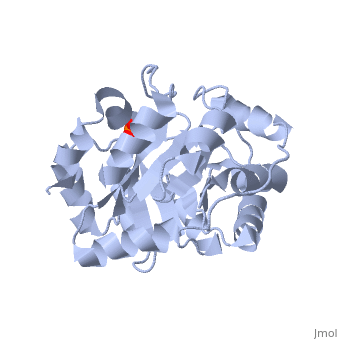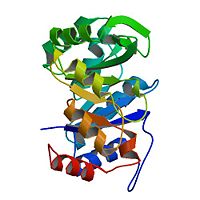Kemp eliminase
From Proteopedia
(Difference between revisions)
| (8 intermediate revisions not shown.) | |||
| Line 1: | Line 1: | ||
<StructureSection load='3uxa' size='400' scene='' caption='Designed kemp eliminase KE59 complex with phosphate (PDB code [[3uxa]])'> | <StructureSection load='3uxa' size='400' scene='' caption='Designed kemp eliminase KE59 complex with phosphate (PDB code [[3uxa]])'> | ||
[[Image:3iio.jpg|left|200px]] | [[Image:3iio.jpg|left|200px]] | ||
| + | __TOC__ | ||
{{ABSTRACT_PUBMED_20036254}} | {{ABSTRACT_PUBMED_20036254}} | ||
A series of [http://en.wikipedia.org/wiki/Protein_design computationally designed enzymes] that catalyze the Kemp elimination have described. Kemp eliminase (KE07) has <scene name='3iio/Int/10'>TIM barrel scaffold</scene>. The Kemp elimination of <scene name='3iio/Int/4'>5-nitrobenzisoxazole</scene> was chosen as a model reaction for [http://en.wikipedia.org/wiki/Proton#Hydrogen_as_proton proton (H)] transfer from [http://en.wikipedia.org/wiki/Carbon carbon], simultaneously with the cut of the [http://en.wikipedia.org/wiki/Nitrogen nitrogen]–[http://en.wikipedia.org/wiki/Oxygen oxygen] (N-O) bond, resulting in <scene name='3iio/Int/8'>cyanophenol product</scene>. Such reaction is a critical step in many [http://en.wikipedia.org/wiki/Enzyme enzymatic reactions]. The [http://en.wikipedia.org/wiki/Enzyme_catalysis catalytic] base (E101), the general acid/[http://en.wikipedia.org/wiki/Hydrogen_bond H-bond] donor (K222), and the stacking residue (W50) make interactions with the 5-nitrobenzisoxazole at the <scene name='3iio/Int/9'>active site of KE07</scene>. [http://en.wikipedia.org/wiki/Directed_evolution Directed evolution] can significantly improve the stability, expression and activity of enzymes. In the catalytically improved directed evolutionary variants of KE07 containing the <scene name='3iio/Ali/7'>Ile7Asp mutation</scene>, Asp7 breaks the Glu101–Lys222 salt bridge (for example [[3iiv]], chain A is shown). | A series of [http://en.wikipedia.org/wiki/Protein_design computationally designed enzymes] that catalyze the Kemp elimination have described. Kemp eliminase (KE07) has <scene name='3iio/Int/10'>TIM barrel scaffold</scene>. The Kemp elimination of <scene name='3iio/Int/4'>5-nitrobenzisoxazole</scene> was chosen as a model reaction for [http://en.wikipedia.org/wiki/Proton#Hydrogen_as_proton proton (H)] transfer from [http://en.wikipedia.org/wiki/Carbon carbon], simultaneously with the cut of the [http://en.wikipedia.org/wiki/Nitrogen nitrogen]–[http://en.wikipedia.org/wiki/Oxygen oxygen] (N-O) bond, resulting in <scene name='3iio/Int/8'>cyanophenol product</scene>. Such reaction is a critical step in many [http://en.wikipedia.org/wiki/Enzyme enzymatic reactions]. The [http://en.wikipedia.org/wiki/Enzyme_catalysis catalytic] base (E101), the general acid/[http://en.wikipedia.org/wiki/Hydrogen_bond H-bond] donor (K222), and the stacking residue (W50) make interactions with the 5-nitrobenzisoxazole at the <scene name='3iio/Int/9'>active site of KE07</scene>. [http://en.wikipedia.org/wiki/Directed_evolution Directed evolution] can significantly improve the stability, expression and activity of enzymes. In the catalytically improved directed evolutionary variants of KE07 containing the <scene name='3iio/Ali/7'>Ile7Asp mutation</scene>, Asp7 breaks the Glu101–Lys222 salt bridge (for example [[3iiv]], chain A is shown). | ||
| Line 14: | Line 15: | ||
The crystal structures of the catalytically improved directed evolutionary KE07 mutants also demonstrate that replacement of side chains via mutations, combined with minor backbone changes, could allowed the new enzyme–substrate interactions. For example, <scene name='3iio/Ali1/5'>superposition</scene> of the structures of the <span style="color:orange;background-color:black;font-weight:bold;">KE07 design</span> and evolved <font color='darkmagenta'><b>KE07 round 4 1E/11H chain A</b></font> ([[3iio]]) reveals that the mutation Gly202Arg caused a shift of the adjacent loop (residues 175–177) and could introduce a new interaction with the nitro group of the 5-nitrobenzisoxazole. The directed evolution also creates new interaction networks of charged surface residues at the upper part of the active site. In the <scene name='3iio/Ali1/6'>wildtype KE07</scene> ([[2rkx]], <span style="color:lime;background-color:black;font-weight:bold;">colored lime</span>), Gly is in the position 202, Asn is in the position 224, and distance between Asn224 O and His201 N is 7.9 Å. In the evolved variants, following the Gly202Arg and Asn224Asp mutations, Asp224 and His201 gradually became closer, with distances between Asn224 O and His201 N of 4.6 Å in the <scene name='3iio/Ali1/7'>round 4 variant</scene> ([[3iio]], <font color='darkmagenta'><b>colored darkmagenta</b></font>) and 3.6 Å in the <scene name='3iio/Ali1/8'>round 7 variant, chain B</scene> ([[3iiv]], <span style="color:tan;background-color:black;font-weight:bold;">colored tan</span>). In rounds 6-7 variants, Asp224 can potentially interact with Arg202 and with His201. This network of Arg202–Asp224–His201 also brings His201 closer to the substrate (not shown). Interestingly, the <scene name='3iio/Ali1/9'>conformation of Trp50</scene> at the active site in <span style="color:lightskyblue;background-color:black;font-weight:bold;">chain A of round 7 1/3H variant</span> ([[3iiv]]) significantly differs from those in all other structures, including <span style="color:tan;background-color:black;font-weight:bold;">chain B</span>) within the asymmetric unit of round 7 1/3H. Of note, that Trp50 of chain A overlaps the substrate. For more details see [[Kemp elimination catalyst]]. | The crystal structures of the catalytically improved directed evolutionary KE07 mutants also demonstrate that replacement of side chains via mutations, combined with minor backbone changes, could allowed the new enzyme–substrate interactions. For example, <scene name='3iio/Ali1/5'>superposition</scene> of the structures of the <span style="color:orange;background-color:black;font-weight:bold;">KE07 design</span> and evolved <font color='darkmagenta'><b>KE07 round 4 1E/11H chain A</b></font> ([[3iio]]) reveals that the mutation Gly202Arg caused a shift of the adjacent loop (residues 175–177) and could introduce a new interaction with the nitro group of the 5-nitrobenzisoxazole. The directed evolution also creates new interaction networks of charged surface residues at the upper part of the active site. In the <scene name='3iio/Ali1/6'>wildtype KE07</scene> ([[2rkx]], <span style="color:lime;background-color:black;font-weight:bold;">colored lime</span>), Gly is in the position 202, Asn is in the position 224, and distance between Asn224 O and His201 N is 7.9 Å. In the evolved variants, following the Gly202Arg and Asn224Asp mutations, Asp224 and His201 gradually became closer, with distances between Asn224 O and His201 N of 4.6 Å in the <scene name='3iio/Ali1/7'>round 4 variant</scene> ([[3iio]], <font color='darkmagenta'><b>colored darkmagenta</b></font>) and 3.6 Å in the <scene name='3iio/Ali1/8'>round 7 variant, chain B</scene> ([[3iiv]], <span style="color:tan;background-color:black;font-weight:bold;">colored tan</span>). In rounds 6-7 variants, Asp224 can potentially interact with Arg202 and with His201. This network of Arg202–Asp224–His201 also brings His201 closer to the substrate (not shown). Interestingly, the <scene name='3iio/Ali1/9'>conformation of Trp50</scene> at the active site in <span style="color:lightskyblue;background-color:black;font-weight:bold;">chain A of round 7 1/3H variant</span> ([[3iiv]]) significantly differs from those in all other structures, including <span style="color:tan;background-color:black;font-weight:bold;">chain B</span>) within the asymmetric unit of round 7 1/3H. Of note, that Trp50 of chain A overlaps the substrate. For more details see [[Kemp elimination catalyst]]. | ||
| - | '''KE07, KE59, KE70 and KEhg3.17''' are kemp eliminases with various sets of mutations | + | *'''KE07, KE59, KE70 and KEhg3.17''' are kemp eliminases with various sets of mutations, each one improving the catalytic efficiency of the reaction converting 5-nitrobenzinsoxazole to cyanophenol<ref>PMID: 23380188</ref> |
{{Clear}} | {{Clear}} | ||
| Line 30: | Line 31: | ||
**[[3iio]], [[3iip]], [[3iiv]] – EcKE07 – ''Escherichia coli''<br /> | **[[3iio]], [[3iip]], [[3iiv]] – EcKE07 – ''Escherichia coli''<br /> | ||
| - | **[[4z08]], [[5d2t]], [[5d2v]], [[5d2w]], [[5d2x]], [[5d2y]], [[5d30]], [[5d32]], [[5d37]], [[5d38]] – KE7 – synthetic<br /> | + | **[[4z08]], [[5d2t]], [[5d2v]], [[5d2w]], [[5d2x]], [[5d2y]], [[5d30]], [[5d32]], [[5d33]], [[5d37]], [[5d38]], [[6c7h]], [[6c7m]], [[6c7t]], [[6c7v]], [[6c8b]], [[6cai]], [[6ct3]], [[6dc1]], [[6dkv]], [[6dnj]], [[6nw4]], [[9hvb]], [[9hvh]] – KE7 – synthetic<br /> |
*KE59 | *KE59 | ||
| Line 41: | Line 42: | ||
*KE70 | *KE70 | ||
| - | **[[3npu]], [[3npv]], [[3npw]], [[3npx]], [[3nq2]], [[3nq8]], [[3nqv]], [[3nr0]], [[3q2d]] – EcKE70 <br /> | + | **[[3npu]], [[3npv]], [[3npw]], [[3npx]], [[3nq2]], [[3nq8]], [[3nqv]], [[3nr0]], [[3q2d]], [[8fmd]] – EcKE70 <br /> |
| + | **[[8for]] – EcKE70 + nitrobenzotriazole <br /> | ||
| - | * | + | *KEhg or endo-1,4-beta-xylanase |
| - | **[[ | + | **[[8fme]] – EcKEhg3<br /> |
| + | **[[8fos]] – EcKEhg3 + nitrobenzotriazole <br /> | ||
| + | **[[7k4p]], [[7k4t]], [[7k4v]] – TaKEhg3 – Thermoascus aurantiacus<br /> | ||
| + | **[[5rg4]], [[5rg5]], [[5rg6]], [[5rg7]], [[5rg8]], [[7k4r]], [[7k4s]], [[7k4w]] – TaKEhg3 (mutant) <br /> | ||
| + | **[[7k4q]], [[7k4u]], [[7k4x]], [[7k4y]], [[7k4z]], [[8rd5]] – TaKEhg3 + nitrobenzotriazole <br /> | ||
| + | **[[3nyd]], [[4bs0]], [[5rga]], [[5rgb]], [[5rgc]], [[5rgd]], [[5rge]], [[5rgf]], [[6srw]], [[6sry]], [[6srz]], [[6ss1]], [[6ss3]], [[6tu6]] – TaKEhg3 (mutant) + nitrobenzotriazole <br /> | ||
| + | **[[5rg9]] – TaKEhg4 (mutant)<br /> | ||
| + | **[[8kh3]] – EcKEhg317 + cyanobenzotriazole <br /> | ||
| + | **[[8usk]] – TaKEhg185<br /> | ||
| + | **[[8usl]] – TaKEhg185 + nitrobenzotriazole <br /> | ||
| + | **[[8usi]], [[8usj]] – TaKEhg198<br /> | ||
| + | **[[8usg]] – TaKEhg630 <br /> | ||
| + | **[[8ush]] – TaKEhg630 + nitrobenzotriazole <br /> | ||
| + | **[[8use]] – TaKEhg649<br /> | ||
| + | **[[8usf]] – TaKEhg649 + nitrobenzotriazole <br /> | ||
| + | **[[8fmc]] – EcKE1A53 <br /> | ||
| + | **[[8foq]] – EcKE1A53 + nitrobenzotriazole <br /> | ||
}} | }} | ||
==References== | ==References== | ||
<ref group="xtra">PMID:20036254</ref> <ref group='xtra'>PMID:18354394</ref> <ref group='xtra'>PMID:22685214</ref><references group="xtra"/> | <ref group="xtra">PMID:20036254</ref> <ref group='xtra'>PMID:18354394</ref> <ref group='xtra'>PMID:22685214</ref><references group="xtra"/> | ||
| + | <references/> | ||
[[Category: Escherichia coli]] | [[Category: Escherichia coli]] | ||
[[Category: Dym, O.]] | [[Category: Dym, O.]] | ||
Current revision
| |||||||||||
See also
3D structures of Kemp eliminase
Updated on 15-October-2025
References
- Khersonsky O, Rothlisberger D, Dym O, Albeck S, Jackson CJ, Baker D, Tawfik DS. Evolutionary optimization of computationally designed enzymes: Kemp eliminases of the KE07 series. J Mol Biol. 2010 Mar 5;396(4):1025-42. Epub 2009 Dec 28. PMID:20036254 doi:10.1016/j.jmb.2009.12.031
- Rothlisberger D, Khersonsky O, Wollacott AM, Jiang L, DeChancie J, Betker J, Gallaher JL, Althoff EA, Zanghellini A, Dym O, Albeck S, Houk KN, Tawfik DS, Baker D. Kemp elimination catalysts by computational enzyme design. Nature. 2008 May 8;453(7192):190-5. Epub 2008 Mar 19. PMID:18354394 doi:10.1038/nature06879
- Khersonsky O, Kiss G, Rothlisberger D, Dym O, Albeck S, Houk KN, Baker D, Tawfik DS. Bridging the gaps in design methodologies by evolutionary optimization of the stability and proficiency of designed Kemp eliminase KE59. Proc Natl Acad Sci U S A. 2012 Jun 8. PMID:22685214 doi:10.1073/pnas.1121063109
- ↑ Labas A, Szabo E, Mones L, Fuxreiter M. Optimization of reorganization energy drives evolution of the designed Kemp eliminase KE07. Biochim Biophys Acta. 2013 May;1834(5):908-17. PMID:23380188 doi:10.1016/j.bbapap.2013.01.005
Proteopedia Page Contributors and Editors (what is this?)
Michal Harel, Alexander Berchansky, Joel L. Sussman, Jaime Prilusky
Categories: Escherichia coli | Dym, O. | Khersonsky, O. | Tawfik, D S. | Beta barrel | Lyase | Albeck, S. | ISPC, Israel Structural Proteomics Center. | Alpha-beta barrel | Amino-acid biosynthesis | Cytoplasm | Histidine biosynthesis | ISPC | Israel Structural Proteomics Center | Structural genomic | Topic Page


